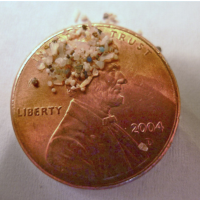San Francisco Bay, and Probably Its Fish, Are Loaded with Plastic Microbeads
 Microbeads (photo: 5 Gyres Institute)
Microbeads (photo: 5 Gyres Institute)
Microplastic contamination in the San Francisco Bay is nine times worse than Lake Erie in the Midwest and 330 times worse than Lake Huron, according to a new study, and fish are gobbling it up.
The report (pdf), from the San Francisco Estuary Institute, said the bay receives a fresh load of plastic, at least 3.9 million pieces daily, from eight sewage treatment plants examined out of 42 that discharge into the bay. Plastic can also enter the bay through storm drains, creeks or illegal dumping.
Although researchers expected to find a lot of plastic, “this was unexpected,” lead author Rebecca Sutton, told the San Jose Mercury News.
The battle over plastic pollution in recent years has centered, in the public mind, on efforts to ban plastic bags. But it has become clear that plastic particles from microbeads and other fragmented sources pose a clearer threat to anyone who doesn’t want to ingest plastic through the food they eat. The plastic can also come from fibers of washed synthetic clothing, Styrofoam or fishing lines.
Tiny plastic pieces can absorb contaminants, like pesticides and polychlorinated biphenyl (PCBs), which can then accumulate in the fish that eat them. That concentration can increase as the contaminant moves up the food chain.
Plastic pollution in the bay varied at nine different locations. Mesh nets, dragged across the water’s surface
The researchers did not set out to study plastic contamination in fish, but they inadvertently swept up a small number while sampling water and found, on average, six pieces of plastic inside each of them.
There are numerous studies documenting the accumulation of plastic in fish. A lot of it comes from the breakdown of larger pieces into digestible forms, but a huge, new threat comes from the popularity of microbeads in personal care products. The tiny particles, no bigger than a grain of sand, are used in toothpaste, soap, facial cleaners and other products.
Hundreds of thousands of the non-biodegradable beads can be found in a single Clinique Exfoliating Scrub or something like it. So it’s safe to say that billions, if not trillions, of plastic pieces are already contaminating the environment.
The federal government doesn’t appear to be close to addressing the problem, but a handful of states have introduced legislation to ban microbeads in cleansing products. In California, lawmakers approved Assembly Bill 888 and sent it to the governor where it awaits his final decision.
AB 888 would prohibit the sale of personal care products whose weight is more than 1 part per million of microbeads—starting in 2020.
The state has not begun to figure out precisely what the largest conduits are for plastic pollution flow into the bay. There has been some talk of installing extra-fine filters in sewage treatment plants, but that would cost hundreds of millions of dollars and still not address all the points of entry.
Considering how difficult it has been to advance legislation banning microbeads in the face of industry resistance, the prospect of them picking up that cost instead of taxpayers appears dubious.
–Ken Broder
To Learn More:
Plastic Pollution: Billions of Pieces of Tiny Plastic Litter Found in San Francisco Bay (by Paul Rogers, San Jose Mercury News)
Millions of Plastic Particles Polluting the San Francisco Bay (by Steve Rubenstein, San Francisco Chronicle)
San Francisco Bay Is More Polluted with Plastics than Any Other Major U.S. Body of Water (by Walter Einenkel, Daily Kos)
States Slowly Move to Ban Microbeads from Soaps and Facial Cleansers (by Noel Brinkerhoff, AllGov)
The Pulse of the Bay (San Francisco Estuary Institute) (pdf)
Microplastic Contamination in San Francisco Bay (by Rebecca Sutton, Sherri A. Mason, Ellen Willis-Norton, Ian F. Wren and Carolynn Box, San Francisco Estuary Institute) (pdf)
- Top Stories
- Controversies
- Where is the Money Going?
- California and the Nation
- Appointments and Resignations
- Unusual News
- Latest News
- California Forbids U.S. Immigration Agents from Pretending to be Police
- California Lawmakers Urged to Strip “Self-Dealing” Tax Board of Its Duties
- Big Oil’s Grip on California
- Santa Cruz Police See Homeland Security Betrayal in Use of Gang Roundup as Cover for Immigration Raid
- Oil Companies Face Deadline to Stop Polluting California Groundwater





